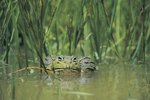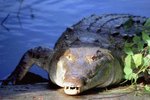The fierce-looking horned frog (Phrynosoma hernandesi), also known as the horny toad, is neither a frog or a toad, but a lizard. He received the nickname due to his blunt snout and squat, rounded body, which resemble that of a frog or toad. Despite the horned frog's crown of sharp horns and many spikes along his back, they're not enough to deter predators, which include hawks, cats, dogs, coyotes and wolves. To defend himself, the horned frog employs several unique strategies.
Camouflage
The horned frog's coloring closely matches the ground and dirt where he lives, which is hot, dry and sandy environments of North and Central America. As a result of effectively blending into the environment, the horned frog is more difficult for predators to spot. The back and head of the horned frog is typically desert gray, and body markings are various shades of yellow, tan, brown or red. With the ability to quickly change his coloring from light to dark or vice versa in only minutes, a horned frog can further camouflage himself from a predator hot on his trail.
Stop and Start
When threatened, the horned frog's initial defense is to stop in his tracks and remain completely still. If the predator moves closer and he's forced to move, the horned frog will quickly run a short distance, abruptly stop, run again and then stop, which confuses the vision of the predator. Hissing and throwing his head toward the predator is another defense mechanism designed to intimidate and frighten. If the show of bravado fails, the horned frog has the ability to flatten his body against the ground and eliminate his shadow, making him difficult to spot.
Body Defense
If a predator tries to grab the horned frog with his mouth, the horned frog will push that side of his body into the ground, which causes the frustrated predator to be unable to maneuver his lower jaw underneath to lift or bite him. To avoid being picked up by the head or neck, the horned frog will stick his horns straight up in a threatening manner or use them to poke the predator until driven away. He appears less appetizing to a hungry predator by filling his lungs with air and puffing up his spiky body until it resembles a large spiny balloon, too big for many predators to swallow.
Shooting Blood
Squirting blood from his eyes directly at predators is the horned frog's most unique defense mechanism. The blood shoots out of ducts in the corners of his eyes and can travel up to three feet. Horned frogs achieve this feat by stopping the blood flow leaving their head, which increases blood pressure and causes the sinus walls to break, allowing blood to shoot out. Not only does the shooting blood confuse and stun predators, it contains a chemical that's toxic to coyotes, dogs and wolves. The blood also has a foul taste, causing the predator to lose his appetite for the horned frog. The lizard can repeatedly shoot blood until the predator is finally frightened off.




